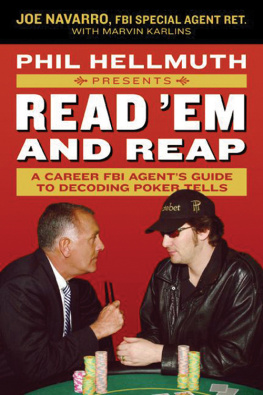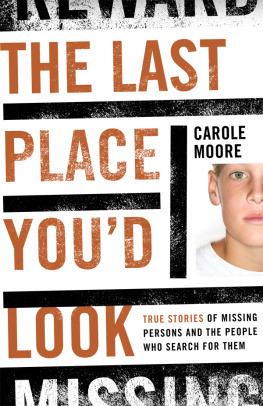







WHAT EVERY
BODY
I S S AY I N G
An Ex-FBI Agents Guide
to Speed-Reading People
J O E N A V A R R O
FBI Special Agent (Ret.)
with Marvin Karlins, Ph.D.
To my grandmother, Adelina, whose withered
hands lovingly molded a child into a man.
J O E N AVA R R O
To my wife, Edyth, who has blessed me with her love
and taught me what it means to be a caring human being.
M A R V I N K A R L I N S
C O N T E N T S
Foreword: I See What Youre Thinking
vi
Acknowledgments
x
ONE Mastering the Secrets of Nonverbal
Communication
TWO Living Our Limbic Legacy
THREE Getting a Leg Up on Body Language:
Nonverbals of the Feet and Legs
FOUR Torso Tips: Nonverbals of the
Torso, Hips, Chest, and Shoulders
FIVE Knowledge Within Reach: Nonverbals of the Arms
SIX Getting a Grip: Nonverbals of the
Hands and Fingers
v C O N T E N T S
SEVEN The Minds Canvas: Nonverbals of the Face
EIGHT Detecting Deception: Proceed with Caution!
NINE Some Final Thoughts
Bibliography
Index
About the Authors
Other Books by Joe Navarro with Marvin Karlins
Credits
Cover
Copyright
About the Publisher
F O R E W O R D
I See What
Youre Thinking
Marvin Karlins, Ph.D.
The man sat stoically at one end of the table, carefully crafting his replies to the FBI agents inquiries. He wasnt considered a major suspect in the murder case. His alibi was believable and he sounded sincere, but the agent pressed on nevertheless. With the suspects consent, he was asked a series of questions about the murder weapon:
If you had committed this crime, would you have used a gun?
If you had committed this crime, would you have used a knife?
If you had committed this crime, would you have used an ice pick?
If you had committed this crime, would you have used a hammer?
One of the weapons, the ice pick, had actually been used in the commission of the crime, but that information had been kept from the public. Thus, only the killer would know which object was the real murder weapon. As the FBI agent went down the list of weapons, he vii
F O R E W O R D
observed the suspect carefully. When the ice pick was mentioned, the mans eyelids came down hard and stayed down until the next weapon was named. The agent instantly understood the significance of the eyelid behavior he had witnessed, and from that moment forward the
minor suspect became the primary person of interest in the investigation. He later confessed to the crime. Chalk one up for Joe Navarro, a remarkable human being who, in addition to unmasking the ice-pick killer, is credited with catching scores of criminals, including master spies, in a distinguished twenty-fiveyear career with the FBI. How was he able to do this? If you asked him, he quietly would say, I owe it to being able to read people.
Joe, it turns out, has spent his entire professional life studying, refining, and applying the science of nonverbal communicationsfacial expressions, gestures, physical movements (kinesics), body distance (proxemics), touching (haptics), posture, even clothingto decipher what people are thinking, how they intend to act, and whether their pronouncements are true or false. This is not good news for criminals, terrorists, and spies, who, under his careful scrutiny, usually give off more than enough nonverbal body signals (tells) to make their thoughts and intentions transparent and detectable.
It is, however, very good news for you, the reader, because the very same nonverbal knowledge Joe relied on to become a master Spycatcher,
human lie detector, and instructor at the FBI is what he will be sharing with you so you can better understand the feelings, thoughts, and intentions of those around you. As a renowned author and educator, Joe will teach you how to observe like an expert, detecting and deciphering the nonverbal behaviors of others so you can interact with them more successfully. For business or for pleasure, this knowledge will enrich and magnify your life.
Much of what Joe will be sharing with you in this book was not even recognized fifteen years ago by the scientific community. It is only through recent advances in brain-scan technology and neural imaging that scientists have been able to establish the validity of the behaviors Joe will be describing. Drawing from the latest discoveries in psychology,
F O R E W O R D
viii
neurobiology, medicine, sociology, criminology, communication studies, and anthropologyplus his quarter century of experience using nonverbal behavior in his work as an FBI Special AgentJoe is uniquely qualified to help you succeed in your understanding of nonverbal communications. His expertise is recognized and sought worldwide. Besides being interviewed regularly on programs such as NBCs
Today Show,CNNHeadline News, Fox Cable News, and ABCs
Good Morning America, he continues to conduct seminars on nonverbal communication for the FBI and the CIA, as well as for other members of the intelligence community. He is a consultant to the banking and insurance industries as well as to major law firms in the United States and abroad. Joe also teaches at Saint Leo University and at various medical schools throughout the United States, where his unique insights into nonverbal communication have found a receptive audience among many, including physicians desiring to assess patients with greater speed and accuracy. Joes combination of academic skills and occupational credentialscoupled with his masterful analysis of nonverbal communications in reallife, high-stakes situationshas placed him apart and in the forefront of nonverbal expertise, as you will discover in this book. After working with Joe, attending his seminars, and putting his ideas to work in my own life, I firmly believe that the material in these pages represents a major advance in our understanding of all things nonverbal. I say this as a trained psychologist who got involved in this writing project because I was excited by Joes pioneering work in harnessing the
sci-entific knowledge of nonverbal communications to achieve professional objectives and personal success.
I was also impressed by his reasoned, careful approach to the topic. For example, while observing nonverbals allows us to get an accurate read on many kinds of behavior, Joe warns us that using body language to detect deception is a particularly difficult and challenging task. This is a significant insightrarely recognized by laypeople or by the law enforcement communityand serves as a critical and poignant reminder to be






















